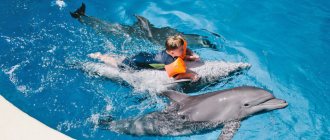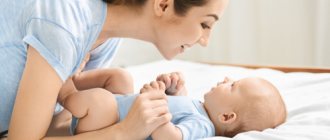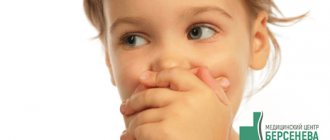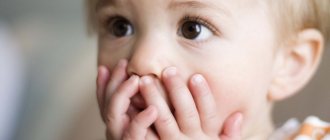Article:
Alalia is a persistent specific speech underdevelopment caused by damage to the cortical parts of both hemispheres of the brain.
Some authors call this childhood pathology “congenital aphasia” or “developmental aphasia” by analogy with the same speech pathology in adults. There is a significant difference here - in adults, already formed speech disintegrates, and in children there is speech underdevelopment due to damage to the speech zones of the cerebral cortex (Broca's area). Similar changes occur during fetal development or early childhood. The following types of alalia are distinguished: motor, sensory and sensorimotor. Let's look at them in more detail below.
Causes of alalia
The severity of the pathology depends on the time of brain damage. The most severe damage occurs during intrauterine development, at 3–4 months of pregnancy. Causes of damage to speech areas:
- maternal intoxication;
- toxicosis of pregnancy;
- incompatibility of mother and baby by blood type and Rh factor;
- birth trauma, asphyxia during fetal development and at birth;
- neuroinfections;
- deep prematurity;
- traumatic brain injuries at an early age;
- consumption of alcohol and nicotine by a pregnant woman;
- hereditary predisposition.
The bottom line is that with organic damage to the brain, the process of maturation of nerve cells slows down. This factor helps to reduce the excitability of neurons and reduce the conductivity of nerve impulses.
Reasons for development
The disease develops against the background of organic damage to the speech centers located in the cerebral cortex. The causes of alalia are disturbances in the functioning of the central and peripheral parts of the human nervous system. Speech underdevelopment is a multifactorial phenomenon.
During the period of intrauterine development of the fetus, brain damage can result from hypoxia, infections, injuries to the mother, or the development of heart and pulmonary failure. During childbirth, damage to the speech centers is provoked by asphyxia or trauma to the newborn’s skull.
In the postnatal period, alalia is caused by various biological factors. Among them is a family history aggravated by ODD and other developmental pathologies. Speech underdevelopment is often diagnosed in children suffering from endocrinopathy and rickets. Surgeries using general anesthesia can have a significant impact on the baby’s condition.
Motor alalia
The fact that with motor alalia both hemispheres of the brain are affected is indicated by the following circumstance - this pathology is not compensated spontaneously, without special corrective work and medical support. The ontogenesis of the disorder involves complex encephalopathic disorders of the cerebral cortex and subcortical structures.
The disease belongs to the third group of clinical types of general speech underdevelopment and occurs in approximately 1% of preschool children and 0.6% of school-age children. An officially recorded diagnosis is the basis for disability.
Characteristic signs of alalia are underdevelopment of absolutely all aspects of speech:
- phonetics;
- vocabulary;
- syntax;
- morphology.
Motor (expressive) alalia in a child received its name because this defect is based on a deficiency in the motor part of speech. An electroencephalopathic study of children with motor alalia diagnoses local damage to the tissues of the cortex, as well as the hypothalamus, subcortical ganglia, thalamus optic, and brain stem. In most cases, dysfunction of the midbrain structures is observed.
Diagnosis of alalia
Speech therapists sometimes find it difficult to diagnose alalia. There are different ways of making a diagnosis, which are designed to complement each other:
- History – collection of information from parents and communication with the child. Alalia can be suspected if at least three characteristic symptoms are present.
- Differential diagnosis. It is necessary to conduct an examination with a number of specialists of a narrow profile. The otolaryngologist must rule out hearing problems, and the psychoneurologist must give his opinion on the mental state. A child psychologist should evaluate him for autism.
- Dynamic examination. When starting correction, the speech therapist must monitor the dynamics of speech development. Based on the information received, the speech therapist can correct the previously made diagnosis.
Diagnosis using MRI and EEG is common. These studies reveal organic lesions and disorders.
Clinical picture and behavioral characteristics of children
With motor alalia, a child may have a large passive vocabulary, but finds it difficult to name even well-known words. Children cannot repeat even simple words after an adult, despite having a developed articulatory apparatus. In words they rearrange and replace syllables, omit sounds. These substitutions are not permanent; in some circumstances, children replace syllables, in others, they replace sounds in the same word.
It is especially difficult for them to pronounce words expressing abstract concepts and generalization words. Children with alalia are aware of their shortcomings. A child with high intelligence is more critical of his speech; when communicating with others, he replaces words with facial expressions and gestures. When parents have excessive demands on pronunciation, when the speech therapist tries to “introduce” sounds, despite the fact that those around him do not understand him, he shows negativism.
The scarcity of phrasal speech is very noticeable - children speak in simple sentences or sentences consisting of only subjects. If you don’t work with your baby, he won’t be able to master the grammatical structure of speech. Children make mistakes in agreeing nouns with prepositions and use case endings incorrectly.
With age, more and more automation of speech is required, and afferent motor alalia in children only increases the child’s problems. Children suffering from this pathology are diagnosed with disorders of attention, memory, thinking, analysis and synthesis of words and phenomena, emotions, will, and behavior.
The symptoms of alalia exclude balanced behavior - it is not often found in children with this speech disorder; usually they are either inhibited or too excited. Most children have impaired fine and gross motor skills, are clumsy, and their movements are disinhibited or slow.
A child with alalia has little desire to understand the surrounding reality; he is inattentive and often distracted. Visual and auditory memory in such children is reduced; such children do not strive for intellectual activity. In the process of completing tasks, they do not strictly follow instructions and therefore often make mistakes.
What is alalia
Alalia in children is a consequence of damage that occurred during the prenatal or early period of life. Without specially developed treatment, children with this disease will not begin to speak independently.
The appearance of speech may be postponed to preschool, and in some cases to a later period. In such children, such speech delay is not associated with hearing and intellectual defects.
Attention! Alalia cannot be treated at home; to make a diagnosis and prescribe therapy, you only need to visit a specialist in person. First of all, you need to contact your local pediatrician, who will refer the child for further examination.
If correctional therapy begins after 4-5 years, secondary speech delay is possible, associated with the mental development of the child. These children have less knowledge about the world around them than their healthy peers. Alalia is characterized by violations of all aspects of speech:
- phonetic;
- lexical;
- grammatical;
- morphological;
- syntactic.
This is a systemic disorder of the speech apparatus, in which it is difficult to learn the rules of functioning of the native language. The vocabulary is poor and ungrammatical. The treatment is complex and systematic over several years. Statistically, boys suffer from it twice as often.
Alalia is a persistent, severe pathology of the speech apparatus. Children with this diagnosis have difficulty acquiring language. They do not perceive speech as a single system. There are cases when a child does not begin to speak even by school age.
Disorders associated with this disease affect the baby's speech and cognitive activity. Later, problems may arise during the formation of personality. There is often a lack of desire for development and interaction with the outside world.
Alalia is characterized by a systemic nature of speech development disorders, which affects all its components. A child with such impairments does not understand speech addressed to him; all communication is reduced to short babbling words.
In subsequent years, a poor vocabulary, agrammatism, incorrect construction of syllables, and disturbances in the pronunciation of sounds are observed. Alalia is one of the most severe speech disorders. It is impossible to solve this complex problem without the help of speech therapists and other specialists.
Sensory alalia
With sensory alalia, the perception of other people's speech is impaired due to damage to the speech-hearing analyzer. Sensory alalia is very rare, perhaps due to imperfect diagnostics.
Features of the pathology:
- Many children with this pathology do not even respond to their own name and do not understand speech addressed to them.
- Children may understand individual words but lose the meaning of statements with the same words.
- In other cases, they understand the instructions for completing the task, but outside of this situation they cannot understand the task.
- Sometimes he incoherently repeats words he knows - logorrhea develops.
Information reaches children's brains in fragments, because they perceive it very poorly by ear. This results in incomprehensible, distorted speech, although the speech activity of such children is quite high.
Realizing their defect, many children become shy, although they do not lose the desire to communicate. Other alaliks are excitable and irritable, and may exhibit negativism and affective outbursts.
In some cases, a complex disorder is diagnosed - sensorimotor alalia.
Classification of pathology
Doctors have developed several typologies of alalia that characterize the main types and forms of this disease. The most widespread classification involves the presence of expressive, impressive and mixed types of speech underdevelopment in children.
The expressive (motor) form of the pathology develops due to damage to the speech motor analyzer located in the cortical part of the brain. The child understands other people's speech, but is unable to reproduce his own.
The impressive (sensory) type of the disease is caused by damage to the speech-hearing analyzer, located in the cortical part of the brain. The patient retains the ability to perceive sounds, but does not understand the speech of others and is not capable of forming his own speech.
Mixed types of ODD suggest that the child has signs of expressive and expressive disorders.
Diagnostic and treatment methods
Children with any form of alalia need the help of a speech therapist, neurologist and psychologist. Neurological diagnostics helps to identify the extent of brain damage using an electroencephalogram and MRI. To exclude hearing loss, otoscopy and audiometry are performed, and in order to differentiate the symptoms of alalia from similar symptomatic pathologies, such as delayed speech development, dysarthria, autism, speech therapists and psychologists are involved in the work of the neurologist.
Sensorimotor alalia requires speech therapy examination. The speech therapist determines the following parameters:
- level of speech understanding;
- determining the number of words in the dictionary, including all speech manifestations;
- identifying opportunities for speech imitation;
- identifying the possibility of using prepositions;
- identifying the state of the organs of articulation and sound pronunciation;
- determining the maximum volume of sentences used;
- research into the possibility of changing words by numbers.
Alalik children with minimal damage to speech development are assessed for the ability to retell a simple fairy tale and answer questions about its content, and the ability to compose a story based on a series of pictures. Diagnosis is carried out in the presence of parents, using a large amount of stimulus material (toys, pictures). The speech therapist strives to establish close contact with the child.
Correction of the defect is carried out in a complex manner. Treatment of alalia in children requires the use of medications that stimulate the maturation of brain structures:
- vitamins B5 and B12;
- Cogitum;
- Gammalon.
{gallery-0}
To eliminate sensory and motor alalia, physiotherapy and microcurrent reflexology are prescribed. Drug treatment of motor alalia will be more effective if it is accompanied by corrective classes with a speech therapist, speech pathologist, or psychologist. Specialists work on the development of speech and other higher mental functions: attention, memory, thinking.
Forecast and preventive measures
Doctors insist on early correction of OHP - before the child reaches the age of four. With the motor type of pathology, the patient retains a high chance of complete recovery. In other cases, the prognosis remains uncertain.
Obstetricians and pediatricians have not developed specific measures to prevent alalia in children during the prenatal and postnatal periods. Doctors recommend that pregnant girls follow standard safety protocols: avoid overwork, significant physical exertion, stressful situations and injuries.
Massage technique
When treating alalia, speech therapy massage is very effective, stimulating speech zones. A full massage cannot be performed without qualifications and the use of special probes. Under the guidance of a specialist, parents can learn the simplest techniques of massaging the face, hands, lips, tongue and carry them out at home on their own. To do this, you can use teaspoons with smooth edges and your mother’s clean, warm hands. Elements of the massage are performed 5 times, all exercises begin and end with stroking.
Sequence of massage movements:
- stroking the forehead from the center to the temples, temples clockwise using the convex side of a spoon or hands;
- the eye sockets are ironed in the same way;
- cheeks are stroked in a circle;
- then the space between the eyebrows is massaged;
- The nose is rubbed, the lip and tongue are massaged.
Hand and face massage is carried out in a warm room. The massage therapist's hands are pre-treated with an antiseptic.
By massaging a child's hands, he develops fine motor skills associated with brain function and speech. It can be performed not only with your hands, but also with rubber balls, prickly curlers, Su Jok. Hand warm-up begins with the little finger, first from its outer side. Then it is recommended to move up along the finger, gently pressing on the pads, then rubbing them. After warming up the palm, its inner side is massaged.
Why does alalia occur?
Alalia can result from asphyxia of the newborn, prematurity, or birth injuries. Sometimes this disorder occurs in children after premature or prolonged labor. Provoking factors can be complications during pregnancy and childbirth, perinatal pathologies. The causes of alalia are usually:
- infectious diseases (infection occurred in utero or during childbirth);
- hypoxia;
- asphyxia;
- toxicosis;
- fetal injury (fall or blow of a pregnant woman);
- TBI during childbirth or pregnancy;
- risk of spontaneous abortion;
- a number of chronic diseases in women (heart failure, pulmonary failure, hypertension and a number of others.
Among the etiopathogenetic factors for the onset of the disease, it is necessary to highlight encephalitis, meningitis, head injuries, and a number of somatic diseases affecting the central nervous system. A number of scientists associate alalia with heredity. Alalik children are seriously different from mentally retarded children. As speech develops, their mental retardation disappears.
Corrective work of a speech therapist
The speech therapist carries out step-by-step work on the formation of oral speech. Each new stage of work is built on the basis of the achievements of the previous stage.
Sequence of training:
- Stimulating imitative activity, expanding the volume of understood speech, forming a one-word sentence from amorphous root words.
- The appearance of the first forms of words, teaching children the ability to construct two-word sentences, expanding the scope of understanding the speech of others.
- Learning to construct a grammatically correct sentence of 2-3 words, reproducing 3-syllable words.
- Constructing sentences of 3–5 words, developing the simplest skills of coherent speech, developing correct sound pronunciation.
- Expanding the volume of sentences, teaching inflection, and the ability to construct complex sentences.
If there are no complex lesions of the cerebral cortex, at the end of the correctional work, children master grammatically correct spoken language. With any form of alalia, early literacy training is necessary, since reading and writing help consolidate the learned material and control oral speech.
Correction of speech underdevelopment
Treatment of alalia involves a combination of medications with psychological and pedagogical techniques. Patients may require assistance from employees of specialized preschool institutions or correctional centers.
The medications prescribed to the child are designed to stimulate the maturation of neurons. Hardware procedures (electrical stimulation, laser therapy, magnetic therapy) help improve fine motor skills and restore coordination of movements. A significant role in the correction of OHP is given to game tasks that develop memory, attention and thinking.
Systematic sessions with a speech therapist will allow the patient:
- form the vocabulary necessary for communicating with peers and relatives;
- learn to construct grammatically correct phrases;
- eliminate phonetic defects;
- master coherent speech skills.
Often, speech therapists show the child special physical exercises that allow him to improve the pronunciation of individual sounds or their combinations.
Silence mode when correcting sensory alalia
The speech therapist recommends to parents how to properly organize the baby’s speech and sound modes. Temporarily, adults are asked to talk to the child as little as possible, organizing a quiet hour or a hearing rest day. During this time, it is necessary to eliminate unnecessary sounds in the children's room: a playing TV, a computer, a tablet; sometimes it is recommended to remove sounding visual stimuli (toys, books). This sound mode helps to increase children's sensitivity to sounds.
The next stage is the awakening of interest in the sounds surrounding the child, the emergence of interest in imitation and perception of one’s own speech.
In the first lessons, the speech therapist develops attention, helping the child to focus on sound stimuli, teaching him to distinguish between two or three sounding objects, for example, a pipe, a tambourine and spoons. Then he is given the opportunity to play various games that will help him develop correct, smooth, diaphragmatic breathing.
At the next stage of correction, the speech therapist’s main task is to draw the child’s attention to laughter, crying and other reactions of people around him, to develop perseverance and the ability to copy the emotional reactions of others. If he is tired, the lesson stops. For the work of a speech therapist to be successful, correction is carried out from 2.5-3 years. The specialist must systematically influence each component of speech.
Alalia.ru
Hello, dear parents! I, like all of you, came to this site to tell our story, to share victories, I am sure that there will definitely be them!! and receive support and valuable advice. I will be glad for any, even the smallest and most insignificant hint, any advice. I really want to help my child in every possible and impossible way. My son's name is Maxim. We are now 3 years 10 months old. Our diagnosis: Neurosis, level 1 ODD, CPRR motor alalia. We don't talk at all. He understands speech at the everyday level: go for a walk, swim, eat, play, wash your hands, etc. There is babbling, soft words “ma-ma-ma”, “pa-pa-pa”, “ba-ba-ba” “ko-ko-ko”, “pi-pi-pi”, “beep-beep-beep” and some in Tarobar language. I would like to note that he says them whenever he wants. When the mood is good, when you ask him to speak, he almost never speaks. If you ask him to say how the plane flies, he says “uuuuuuu” and raises his hand high (this means the plane flies like this), they showed it 1 time, he remembered. That's the only thing he repeats. Sometimes he repeats “ko-ko-ko” when you ask: “Say ko-ko”, if you ask how the chicken speaks, he will not say, although many times they said that she says “ko-ko-ko”. When he wants to call someone somewhere, he takes you by the hand and leads you where you need them, leads you and, poking your hand where you need them, says “ah.” He doesn’t point a finger, he just points with all his fingers in the right direction. She doesn’t call her mom, dad, or grandma, although she knows exactly who is who. He says these words just when he wants. Our motor skills are poorly developed, both large and small. He doesn’t dress himself, he puts on his pants in one leg and whines that he can’t put his leg in, although 100,500 times they showed how to spread out two pant legs and put one leg in them, he can put on his underpants himself, but if you put them on correctly, if not, then he can wear on the left side or backwards. He can no longer put on any clothes himself. He eats on his own, but not carefully, he’s in a hurry, he loves to eat, VERY! eats almost everything. My husband and I take turns eating because if he sees it, he begs and cries with burning tears as if he wasn’t fed, although he ate 10 minutes ago. When I feed my youngest daughter (she is 11 months old) purees or porridge, I take 2 spoons, otherwise he will burst into tears. He can eat meat puree with dollops, at the same time ask dad, who is drinking tea, for a waffle or cookies and then eat meat puree again. We checked for all parasites, everything is fine, we did an ultrasound of the internal organs, there were minor changes in the pancreas, but this is not critical, otherwise everything is fine. He loves to draw) He just draws lines on paper, when I want to draw circles or a sun with his hand, for example, he pulls out his hand, like it’s not possible. In the book, when he shows something, he says “ah” and points not with his finger, but with his whole palm, lately I’ve been teaching him to point with one finger, but he simply bends it further than the others, he doesn’t understand into a fist that he needs to curl it up, when I try to point it doesn’t fixate into the fist. Sometimes he points with one index finger without prompting, but this happens rarely. We descend from the fox cubs at a brisk pace, we are still not very tall, 93 cm. Today we learned how to blow soap bubbles, at first I just blew on them, and then I started blowing to blow it, my joy knew no bounds! As for treatment, we prescribed Cortexin, Magnesium B6, and Phenibut. Cocarboxylase was recently diagnosed. We signed up for the pool, he really likes it. We visit a speech therapist. She has a technique in which all the letters are sung. But we don’t repeat anything, he sits and listens and systematically points to the door and says “ah,” meaning let’s get out of here). I don’t know if we need these classes or maybe some other type of class would be more useful, because he refuses to repeat. The pictures do not always show correctly where the girl is running and where she is sitting, and may not even point to the girl, but to a cat or someone else. I hope that the information accumulation effect still occurs. I want to try hippotherapy, unfortunately we don’t have dolphins, but I think horses are good too. The PMPC commission transferred us to a garden with a compensatory group. We went to a geneticist, tested urine for genetic abnormalities, but none were detected. We will also take an x-ray of the cervical spine to rule out birth trauma. The second big problem for us is the potty. We know what it is, we know what it’s for, but we go to it every once in a while. I have to constantly remind myself. He begins to pee in his pants, clenches himself, but doesn’t sit on the potty until you tell him to (it’s not about the potty, this also applies to the toilet). They checked the urine and saw the surgeon, they said it was neurogia. Sometimes he sits on the potty on his own, but in most cases he doesn’t, basically the same story. It’s very problematic in kindergarten because he doesn’t take him to the toilet, the teachers themselves regularly take him to the toilet. If they don’t take him away, he’ll piss in his pants, and just by pissing, he’ll piss little by little and piss more and more, that is, he doesn’t just take it and piss in his pants, but just a little bit, as if he can’t stand it anymore. At night I put on a diaper, which doesn’t always last until the morning. To be honest, I give up... sometimes I start to lash out at my child and my family, I just don’t have the strength. I really want to believe that I can get out of this disease, I really want to help the child, I want to go to a normal school. I really ask for your help! Maybe I’m doing something wrong or not doing something, I just have an 11-month-old daughter and not everything is going smoothly with her either, I don’t have the opportunity to fully study with Maxim at home, because I have to look after both of them. I really hope for your support and help, tell me where to turn and how else I can influence and help the child. Thanks in advance to everyone!!
Prognosis and prevention
With properly organized and carefully carried out work to correct motor alalia, it is possible to almost completely compensate for this defect by the beginning of schooling and overcome the danger of further speech and intellectual underdevelopment. But such children have a high risk of developing dysgraphia and dyslexia during their schooling. Children with complex damage to brain structures or for whom correctional work began late will not be able to overcome this pathology of speech development. Therefore, in the future they are sent to special schools to continue correctional work.
To prevent the appearance of such a complex pathology, it is necessary to carefully screen the health status of pregnant women, rationally manage childbirth, and protect children from contracting neuroinfections and injuries.
That's all. Now you know how the forms of alalia differ and how to treat it, and whether this disorder can be cured without the services of specialists.
Alalia correction
Children suffering from alalia have difficulties in raising them. Some parents may treat such children unfairly. They do not understand all the problems that the baby faces along the way. It is important to realize that such children require a special approach based on calm, patience, and understanding.
If a parent notices the first symptoms of alalia, they should immediately seek help from specialists. The sooner a problem is identified, the easier it is to deal with it. Timely correction will reduce the risk of complications.
The treatment of these disorders includes various techniques and methods. There are psychological, pedagogical, and medicinal approaches. The technique of transcranial electrical stimulation has a special contribution to the restoration of speech capabilities. Correction stages based on special classes must also go through:
- gymnastics;
- Speech therapy rhythm classes (logorhythmics);
- artistic and technical classes,
- reading;
- writing classes;
- speech therapy classes;
- memory training;
- special classes aimed at attention and perception;
In special correctional centers and speech therapy schools, special medical and psychological therapies are used. The drug approach is primarily aimed at stimulating and shaping damaged brain centers. Experts note the effectiveness of some procedures:
- DMV;
- IRT;
- hydrotherapy;
- laser therapy;
- electrophoresis;
- magnetic therapy;
- electropuncture;
- transcranial electrical stimulation.
The correction program is selected individually and must take into account all the characteristics of the child. The recovery process should influence the pathology itself and its accompanying diagnoses.
Treatment of motor alalia in children
When treating, emphasis should be placed on the development of the child’s motor skills, his thinking, and his ability to remember. Since this disease has a systemic nature of occurrence, the speech therapy approach is adjusted to the full coverage of sound-letter productions, visualization, and the ability to concentrate attention on something. This should be a whole range of measures that have an impact on:
- speech stimulation;
- meaningfulness of speech;
- formation and expansion of vocabulary;
- grammatical development of speech.
Multidisciplinary specialists, not just speech therapists, take part in treatment and correction. A child with alalia needs to be taught the alphabet and letters as early as possible. These skills will help to better develop memory, teach how to form words from individual sounds, and control speech.
Home therapy for alalia
In addition to classes with specialized specialists, you can conduct additional classes at home. To get rid of the disease, the parent must focus as much as possible on his baby and help him. There are some effective methods designed specifically for patients:
- The baby must learn to understand speech by ear. The parent names the object, the child must show it. If he showed it wrong, you need to show it correctly. This exercise is repeated many times for alaliks before he understands what is required of him. Bright toys and colored figurines are suitable for such activities.
- If the vocabulary is wide, train him to pronounce the names of objects by showing them.
- You need to talk to children suffering from alalia more often. Parents' speech should be clear, correct and not too fast. With sensory alalia, words must be accompanied by a demonstration of corresponding pictures.
- Show the letters. And then say words starting with these letters. Ask your child to show the letter with which the word begins and pronounce the whole word.
Take your child a few books with bright illustrations and get him interested in reading. Tell interesting stories and show what the main characters look like. Educational games with adults can help.
Treatment of sensorimotor alalia in children
Therapy for children diagnosed with sensorimotor alalia should be comprehensive, based on the individual characteristics of the disease in a particular child. It is also necessary to be systematic and attend classes regularly.
Treatment consists of medical, speech therapy, and psychological assistance.
The medical component of therapy consists of prescribing medications that stimulate brain metabolism and restore connections between neurons. Nootropics, multivitamins and other groups of drugs are used as needed. The course includes physiotherapeutic techniques (laser therapy, acupuncture, electrophonophoresis, electrical stimulation, magnetic therapy), massage.
Massage technique for alalia
Massage has a positive effect on the motor type of the disease. It has a number of positive effects: reduces increased muscle tone;
- coordinates the muscles of the face and tongue;
- improves articulation;
- improves tissue sensitivity;
- reduces salivation (excessive salivation, drooling).
The massage should be done with your fingers. Movements should be slow and careful. There should be at least 10 such sessions per course. The massage technique includes tapping on the lips, tongue, and inner surface of the cheeks.
You also need to carry out circular and pressing movements along the surface of the cheeks. It is worth seeking help from specialists who will prescribe a course of speech therapy massage and determine its features, frequency, and specific movements.
Prevention of alalia
This disease can be congenital or acquired. Scientists have identified certain patterns in the appearance of this serious disease. It can appear after fetal hypoxia, a number of complications during pregnancy, and early childbirth.
Prevention of natural causes is impossible or extremely difficult. The baby may suffer a head injury during childbirth. Alalia is also caused by etiopathogenetic factors. These include:
- rickets;
- viral encephalitis;
- TBI;
- malnutrition;
- meningitis;
- viral diseases and complications after them.
A number of these reasons can be completely avoided, thereby minimizing the risk of pathology. These are the following measures:
- parents should give up bad habits;
- Before planning a pregnancy, undergo all the necessary tests to identify diseases in the mother.
- During pregnancy, the mother should avoid infection with viral infections and exacerbation of chronic diseases as much as possible.
- use medications that are safe for the fetus.
- undergo all required examinations during pregnancy.
- After birth, it is necessary to talk and engage in educational games.
- If symptoms of mental or neurological disorders appear, immediately contact a speech therapist, child psychologist or neurologist.
- carry out vaccinations prescribed by doctors, including for mother.
Such preventive measures will ensure good development of the nervous system, development of speech and motor skills.






